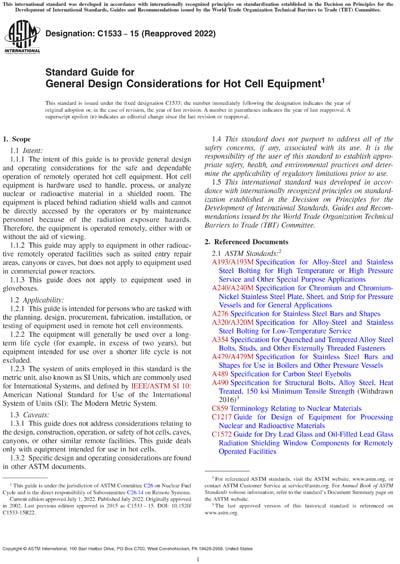Most recent
ASTM C1533-15(2022)
Standard Guide for General Design Considerations for Hot Cell Equipment
1.1Intent:
1.1.1The intent of this guide is to provide general design and operating considerations for the safe and dependable operation of remotely operated hot cell equipment. Hot cell equipment is hardware used to handle, process, or analyze nuclear or radioactive material in a shielded room. The equipment is placed behind radiation shield walls and cannot be directly accessed by the operators or by maintenance personnel because of the radiation exposure hazards. Therefore, the equipment is operated remotely, either with or without the aid of viewing.
1.1.2This guide may apply to equipment in other radioactive remotely operated facilities such as suited entry repair areas, canyons or caves, but does not apply to equipment used in commercial power reactors.
1.1.3This guide does not apply to equipment used in gloveboxes.
1.2Applicability:
1.2.1This guide is intended for persons who are tasked with the planning, design, procurement, fabrication, installation, or testing of equipment used in remote hot cell environments.
1.2.2The equipment will generally be used over a long-term life cycle (for example, in excess of two years), but equipment intended for use over a shorter life cycle is not excluded.
1.2.3The system of units employed in this standard is the metric unit, also known as SI Units, which are commonly used for International Systems, and defined by IEEE/ASTM SI 10: American National Standard for Use of the International System of Units (SI): The Modern Metric System.
1.3Caveats:
1.3.1This guide does not address considerations relating to the design, construction, operation, or safety of hot cells, caves, canyons, or other similar remote facilities. This guide deals only with equipment intended for use in hot cells.
1.3.2Specific design and operating considerations are found in other ASTM documents.
1.4This standard does not purport to address all of the safety concerns, if any, associated with its use. It is the responsibility of the user of this standard to establish appropriate safety, health, and environmental practices and determine the applicability of regulatory limitations prior to use.
1.5This international standard was developed in accordance with internationally recognized principles on standardization established in the Decision on Principles for the Development of International Standards, Guides and Recommendations issued by the World Trade Organization Technical Barriers to Trade (TBT) Committee.
Content Provider
ASTM International [astm]






